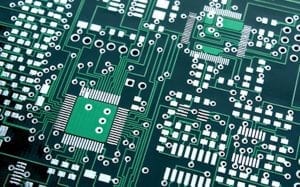WHAT EXACTLY ARE PCB’s?

A BRIEF HISTORY OF THE PRINTED CIRCUIT BOARD
The precursors of printed circuit boards have a history dating back to the 1850s. Originally, rods or strips of metal were employed to connect electrical components in large units mounted on wooden bases. Eventually, smaller units were needed for the many products being developed that required electrical conduction. A 1925 invention placed electrically conductive inks on an insulated surface to create an electrical path, giving rise to the name “printed circuit.” A further evolution came with the advent of transistors, which needed a smaller-sized package. To accommodate the size constraints, PCBs were designed using etched circuits on a copper foil surface which was bonded to a non-conductive base.
EARLY USES OF PCB’s
Initially, PCBs used wire leads which passed through holes and were soldered in place. This was known as through-hole construction. Over time, more sophisticated board lamination and etching techniques evolved into the PCB fabrication process used in modern electronic components. Small surface mounted parts are usually used instead of through-hole construction, providing more options in functionality and reduced production costs.
PCBs have a distinct advantage over their predecessor circuits, which had to be painstakingly wired point to point, leading to junction failures and short circuits. PCBs’ connections are made using metal solder, a durable mechanical adhesive that conducts electronic signals.
WHAT ARE PCB’S MADE OF?
Printed circuit boards are made up of several different layers which are laminated together. The substrate, or base, is typically fiberglass for rigid PCBs. Flexible plastic such as polyamide is used in flexible printed circuit boards. Flexible PCB manufacturers also offer rigid flex circuit boards which combine flexible PCBs’ high pliability with the structural capabilities of a rigid PCB.
PCB MANUFACTURING OPTIONS
Printed circuit board manufacturers like PCB Solutions can create a diverse selection of PCBs for the vast array of electronic products that require them. Modern manufacturing techniques allow for creative designs with unique specifications. PCB designs can be manufactured according to the particular technical specifications required by the final result desired, ensuring that electronics manufacturers can create the products they envision.

